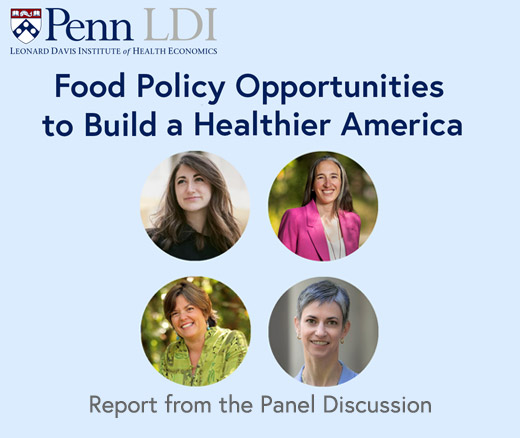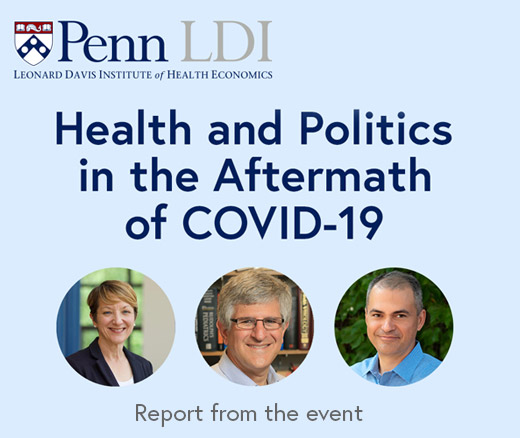
Contradictions That Confuse Federal Food Policies
Announcing Bold New Goals While Crippling the Infrastructure Needed to Achieve Them
Population Health
Blog Post

LDI Senior Fellow Andy Tan, Director of the Health Communication & Equity Lab at Penn’s Annenberg School for Communication, has a huge aversion to cigarette smoke. “My husband labels me a ‘super taster.’ I can smell cigarette smoke from half a block away,” he said. Yet this distaste does not translate into a lack of empathy for people who are dependent on cigarettes.
Tan, who trained in preventive medicine in his native Singapore and then obtained degrees in Public Health and Communication in the U.S., is more interested in countering the commercial causes of tobacco use, particularly among marginalized people. “There’s a multibillion-dollar industry behind why over 28 million American adults are still dependent on cigarette smoking. It really goes beyond the individual,” Tan said.
In the early 2010s, Tan’s cancer prevention research at Penn faced a new urgency. “Because of declining smoking rates since the 1960s, we thought we were getting smoking under control, but a new threat arrived in the form of electronic cigarettes [e-cigarettes],” said Tan.
For the last eight years, the Associate Professor of Communication has been especially interested in nicotine use among LGBTQ+ individuals, who smoke and vape at rates higher than their hetero peers. With Project Resist, a study to test messaging, Tan and colleagues have broken new ground in designing messages that promote quitting.
Here are some of their important findings.
Lesbian, gay, and bisexual (LGB) individuals use tobacco products more often than other Americans. According to the CDC, 25% of LGB people currently smoke, compared to 19% of non-LGB people. The differences are starker among certain subgroups. For instance, in a 2020 report, young adult (18-25) sexual and gender minority (SGM) women evidenced higher rates of combustible cigarette (44%) and e-cigarette use (9%) than their heterosexual peers (18% combustible and 3% e-cigarette use).
Why the higher rates? “It’s been well-documented that the SGM population experiences, on average, higher levels of stress than the non-SGM population. SGM people may internalize homophobia and encounter discrimination and harassment in their lives. This added stress over and above normal day-to-day stressors is one of the risk factors associated with higher rates of substance use, including the use of tobacco products,” explained Tan.
Stress can be compounded by what is known as “intersectionality”—the intersection of several categories of disadvantage. “In the context of LGBTQ+ populations, if you layer on additional axes of discrimination such as sexism, racism, and classism, these disadvantages can lead to the health disparities becoming greater than the sum of the parts,” explained Tan. For instance, in a 2022 study, Tan and a coauthor found that the difference in e-cigarette usage between young LGB Black females and non-LGB Black females is much bigger than the difference between LGB white females and non-LGB white females.
Another factor contributing to increased tobacco use among LGBTQ+ people is tobacco products’ advertising specifically aimed at them. “Formerly classified tobacco industry documents show that the tobacco industry has targeted the LGB community with its marketing efforts for decades,” wrote Tan and his co-authors in a 2024 article in Annals of LGBTQ Public and Population Health. “Pro-tobacco content appears in print magazines, websites, and content by social media influencers. Cigarettes and e-cigarettes are marketed in person at bars, clubs, and music venues that attract an LGB audience, such as a Lesbian Film Festival and Pride events,” Tan said.
The marketing reaches its target audience. A 2019 study co-authored by Tan found that SGM adolescents were more often exposed to online tobacco content than their non-LGBTQ+ peers. In addition, tobacco advertising may be more effective at appealing to certain segments of the community. The 2019 article suggests that gay and bisexual young male adults are more receptive than their heterosexual peers to content relating to e-cigarettes, while lesbian and bisexual women showed greater receptivity to all forms of tobacco advertising.
After a great deal of research in tandem with LGBTQ+ advisors experienced in the field, Tan and his colleagues created a series of 20 anti-smoking ads tailored to young (18-30) sexual minority women (SMW), both cisgender and transgender, delivered over four times in a month for a 2024 study published in the American Journal of Preventive Medicine.
“We had content pointing out the profiteering and negative actions of the tobacco industry. The tailored and the non-tailored conditions [for a control group], used identical sets of images, photos, and slogans. But at the bottom of our tailored anti-smoking messaging, we had subtle cues, such as rainbow Pride colors in the logo and a slogan that stated this campaign is for LGBTQ+ health,” Tan reported.
The hypothesis was that providing health information tailored to young adult SMW would lead to greater attention to the ads and increase their persuasive effects. Then the tailored messages would cause the women to have higher intentions to quit smoking compared with women exposed to the non-tailored messages. “We didn’t get these results. We didn’t see a significant difference between individuals who were shown tailored anti-smoking messages versus the non-tailored anti-smoking messages in terms of their intentions to quit smoking,” Tan said.
But the group, spearheaded by Penn doctoral candidate Brittany Zulkiewicz, did find after further analysis that for some study subjects, the tailored messaging increased anti-corporate attitudes and beliefs and that these increases, in turn, were correlated with a greater intention to quit smoking. “Broadcasting the harm the tobacco industry does can be seen as a way to motivate young adult sexual minority women to think about quitting,” Tan said.
Tan’s team is now planning on expanding the research to other young adult groups within the LGBTQ+ community such as sexual minority men and transgender and gender expansive people. A second expansion is to study ways to reduce vaping, which is on the rise in this community.
“Community-based organizations (CBOs) run the gamut of having only three staff members sitting around the kitchen table in someone’s home, all the way to a highly resourced LGBTQ+ federally qualified health center with a full-fledged research institute, and everything in between. We wanted to find out what these groups need when we show them the results from Project Resist,” Tan said.
After a series of interviews and workshops (detailed here, here, and here), Tan and his colleagues realized that they “couldn’t just hand CBOs a packet of messages and say, ‘go forth and prosper.’ Their feedback to us was, ‘We want to know the method you use for generating this science, and we want to know local data that are directly and uniquely relevant to the communities we serve. And then we want a set of adaptation approaches or tools that will allow us to make changes to the packaging around these anti-tobacco messages,’” Tan explained. Examples of adaptation supports include customizable surveys and focus-group interview guides, webinars, storytelling activities, and technical assistance.
Tan feels that disseminating information to community-based organizations is critical to his mission. The next big challenge for Tan and his team is to co-design a communication adaptation approach with inputs from partnering LGBTQ+ community organizations. They also plan to conduct field tests to assess the feasibility and utility of community organizations using the co-designed approach across different geographic locations.
“We don’t want our results to just sit on the shelves in the form of peer review journals. We want our research to be impactful and usable and translatable by folks on the front line who can deliver these health messages to a much larger audience,” Tan said.


Announcing Bold New Goals While Crippling the Infrastructure Needed to Achieve Them

Promising New Evidence and What’s Next

From 1990 to 2019, Black Life Expectancy Rose Most in Major Metros and the Northeast—but Gains Stalled or Reversed in Rural Areas and the Midwest, Especially for Younger Adults

A Penn LDI Seminar Focuses on Why They’re Important for the Future

Former Philadelphia Health Commissioner Warns That Gutting the CDC, Undermining Vaccines, and Politicizing Science Will Leave the U.S. Dangerously Unprepared for the Next Pandemic

Rural Parents Had More Emergency Visits and Insurance Loss Than Urban Peers, an LDI Study Shows. Integrated Baby Visits Could Help All Parents Be Healthier